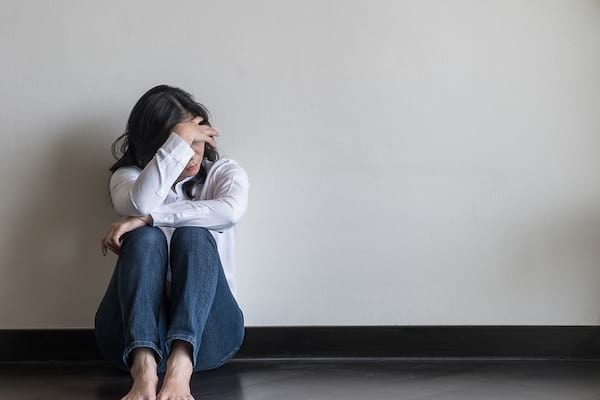Skip To Section
Doctors don’t hand out sedatives and tranquilizers without weighing the pros and cons. If your practitioner thinks you need them, they have valid reasons. But it’s important to know that these medications aren’t inherently risk-free, so you can talk to your doctor about any concerns or questions you have.
Even when taking a sedative or tranquilizer drug as prescribed, you can develop tolerance. Tolerance means needing more of the substance to get the same desired effects. You may also experience withdrawal symptoms if you try to quit.
Some people take more of their prescription than suggested. Others misuse drugs without having a prescription in the first place. These risk factors can increase your chance of developing an addiction.

What Are Sedatives?
Sedatives work on your central nervous system. They slow down brain activity and can help you feel more relaxed and calm. Doctors often prescribe sedatives to treat sleep disorders and anxiety. They’re also used for general anesthesia.
In some cases, these drugs can cause euphoria. They also tend to cause other side effects, including:
- Poor judgment
- Memory issues
- Coordination problems
Severe side effects may include:
- Agitation
- Aggression
- Paranoia
- Suicidal ideation
There are three main types of sedatives, and each works slightly differently:
- Barbiturates
- Benzodiazepines
- Z-drugs
Barbiturates
Barbiturates can treat:
- Insomnia
- Headaches
- Seizures
While popular in the 1950s and 1960s, they are rarely prescribed today. Barbiturates include substances like Nembutal, Seconal, and Amytal. Doctors now tend to prescribe benzodiazepines instead of barbiturates to treat the same things.
Benzodiazepines
Benzodiazepines, or benzos, are used to treat several conditions, including:
- Anxiety
- Panic
- Sleep issues
- Alcohol withdrawal
Common benzodiazepine drugs include:
- Xanax
- Ativan
- Valium
- Klonopin
Today, benzodiazepine prescriptions are extremely common. Research shows they’re prescribed at about 66 million doctors’ appointments per year.
When used properly for short time periods, benzos may help ease symptoms of anxiety. But the longer you take them, the higher the risk of tolerance. Some long-term users abuse their pills.
Z-Drugs
Z-drugs are usually prescribed for sleep issues.
Common Z-drugs include:
- Sonata
- Lunesta
- Ambien
In general, Z-drugs are considered to be a safer alternative to benzodiazepines, as they have less potential for abuse and dependence. They work by targeting the same receptors in the brain that benzodiazepines do, which are a class of drugs commonly used for anxiety and sleep disorders.
However, like all medications, there can be side effects when taking Z-drugs. Some common side effects include dizziness, dry mouth, and headaches. More serious side effects may include memory loss or hallucinations.
It is important to follow your doctor’s instructions when taking Z-drugs and not exceed the prescribed dosage. Taking larger amounts or using these drugs recreationally can lead to dangerous consequences.
What Are Tranquilizers?
Just like sedatives, tranquilizers can treat anxiety and sleep issues, but they also act to stabilize your mental health conditions, like bipolar disorder. Your doctor might prescribe a tranquilizer to you to help you cope with a short-term crisis. If you’re feeling as though suicide is an option, for example, these medications could help you to feel calm and capable of making good decisions.
In general, tranquilizers don’t make you sleepy, but they do calm your body down when it’s going through a lot of turmoil. For example, if you’re experiencing panic attacks or severe anxiety, a tranquilizer can help to reduce those symptoms and allow you to focus on managing your mental health.
There are two main types of tranquilizers:
- Antipsychotic medications
- Anti-anxiety medications
Antipsychotic Medications
Antipsychotic medications, also known as neuroleptics, are a class of drugs used to treat mental disorders such as schizophrenia, bipolar disorder, and severe depression. They work by altering the levels of certain chemicals in the brain that can affect mood and behavior.
There are two main types of antipsychotics which include:
- Typical antipsychotics: these medications have been around since the 1950s and primarily work by blocking dopamine receptors in the brain.
- Atypical antipsychotics: these medications were developed in the 1980s and not only block dopamine receptors but also affect other neurotransmitters such as serotonin and norepinephrine.
Each medication may have different benefits and potential side effects, so it is important to discuss with your doctor which one may be best for you.
While that can be helpful, these medications can also cause side effects like:
- Weight gain
- Sedation
- Increased risk of developing type 2 diabetes
It’s very important to avoid dangerous drug interactions with antipsychotics. Unfortunately, research shows that about 17% of people who use them also use cocaine, alcohol, meth, or opioids.
Anti-Anxiety Medications
Anti-anxiety drugs are also known as anxiolytics, and they work by altering the brain’s messaging system. Benzodiazepines are included in this class. They work by enhancing the effects of GABA, a neurotransmitter that helps to calm down excessive activity in the brain.
These drugs are typically prescribed for short-term use to treat acute anxiety and panic disorders. They can also be used to help manage symptoms of other mental health conditions such as insomnia, seizures, and muscle spasms.
Commonly prescribed benzodiazepines include:
- Xanax (alprazolam)
- Klonopin (clonazepam)
- Valium (diazepam)
- Ativan (lorazepam)
These medications can be highly effective in providing quick relief from anxiety symptoms, but they also carry a high risk for dependency and abuse.
"*" indicates required fields
Fill out the form below and one of our admissions team members will reach out to you:
"*" indicates required fields
What Does Addiction to Sedatives or Tranquilizers Look Like?
Addiction isn’t always straightforward. Many people struggle with just one or two symptoms, and they may not recognize they have a problem. Or they may believe concerned loved ones are overreacting. Over time, however, the issues can progress.
The signs and symptoms of addiction include:
- Taking larger doses than your doctor has prescribed
- Taking doses more frequently than your doctor has prescribed
- Visiting multiple providers to obtain more pills
- Buying pills from street dealers
- Spending most of your time buying or using sedatives or tranquilizers, or recovering from them
- Lying about or downplaying your substance use
- Using pills despite financial consequences or concerns
- Using pills in physically dangerous situations (for example, before driving or while taking care of a child)
- Using pills despite relationship problems
What To Expect In Addiction Treatment for Sedatives and Tranquilizers
When you enter an addiction treatment program for sedative or tranquilizer abuse, you’ll get therapy that can help you to:
- Uncover your strength – You may need to draw on hidden reserves to help you avoid the urge to return to your pills. Your team can help you find that strength through talking, skill-building, and community.
- Find your peers – Addiction can be isolating. You may feel you only connect with people who also use drugs. In therapy, you can find other people who are hoping to quit, just like you are.
- Resolve conflicts – Maybe you made decisions during your addiction that you’re not proud of. Maybe some family members stepped away from you due to those decisions. Your therapist can help you repair that damage with family therapy.
- Heal your spirit – You may have a mental illness in addition to your addiction. That could leave you at risk for relapse. Your team can help you get control of that issue.
Your recovery plan may not look like anyone else’s. You may need things that others do not, or you may not need solutions that they do. Your treatment team can help you to find the program that works best for you, so you can step away from sedatives or tranquilizers for good.
Getting Help for Sedative or Tranquilizer Abuse In Detox
Medical detox is always recommended for stopping sedative use because it may not be safe to quit these substances cold-turkey. Doing so can result in seizures, which can be fatal.
Detox provides 24/7 monitoring and safety by a detox team assigned to you. They may place you on a tapering schedule, which means you’ll take less and less of the drug until you can stop altogether. A physician will closely monitor your symptoms.
Detox lets you stabilize your medical and psychiatric symptoms, but it doesn’t mean you’ve beaten your dependence on tranquilizers or sedatives. After detox, you’ll also receive referrals for treatment and aftercare. These options are crucial because detox alone is rarely sufficient for long-term recovery.
Dual Diagnosis Treatment During Rehab for Sedative and Tranquilizer Abuse
For people who struggle with sedative and tranquilizer abuse, finding the right support and resources can be a daunting task. For those struggling with a co-occurring mental health disorder, the journey to recovery can feel even more overwhelming.
Common mental health disorders that co-occur with sedative abuse include:
- Anxiety disorders
- Sleep disorders
- Seizure disorders
- Mood disorders
- Psychotic disorders
If you have a co-occurring disorder, you might be prescribed non-addictive psychiatric medications to help manage your psychiatric symptoms along with symptoms of withdrawal.
This is another reason being under professional medical care at the beginning of your recovery journey is crucial. The experts can help take care of your brain and body, keeping you safe.
Get Help For Sedative and Tranquilizer Addiction
Don’t let sedatives or tranquilizers control your life any longer. Contact Footprints to Recovery today for help in breaking free from addiction and living a fulfilling life in recovery. With our compassionate team by your side, you can achieve lasting sobriety and find peace within yourself. For more information about our addiction treatment services and programs, reach out today!
- Sedatives: How They Work, Cautions, and Dependency
- Central Nervous System (CNS) Depressants – National Coalition Against Prescription Drug Abuse
- What Are Barbiturates? Examples, Side Effects, Definition
- List of Benzodiazepines: Types, Side Effects, Addiction & Withdrawal
- Taking Z-drugs for Insomnia? Know the Risks – FDA
- Misuse of atypical antipsychotics in conjunction with alcohol and other drugs of abuse – JSAT Journal
- Benzodiazepine prescriptions reach ‘disturbing’ levels in the US
Our admissions team is available 24/7 to listen to your story and help you get started with the next steps.








